MAZDA MODEL 6 2017 Owners Manual (in English)
Manufacturer: MAZDA, Model Year: 2017, Model line: MODEL 6, Model: MAZDA MODEL 6 2017Pages: 578, PDF Size: 54.72 MB
Page 221 of 578

4–97
When Driving
i-ACTIVSENSE
If a vehicle with the Blind Spot Monitoring (BSM) system is driven in \
a country other than
the U.S.A., Canada, or Mexico, the system has to be turned off by changi\
ng the setting on
the center display.
The system switches to the Rear Cross Traffic Alert function when the shift lever (manual
transaxle) or the selector lever (automatic transaxle) is shifted to \
the reverse (R) position.
Refer to Rear Cross Traffic Alert (RCTA) on page 4-111.
Blind Spot Monitoring (BSM) Warning Indicator Lights/Display Indicator/
Blind Spot Monitoring (BSM) Warning Beep
The Blind Spot Monitoring (BSM) or Rear Cross Traffic Alert (RCTA) system notifies the
driver of the presence of vehicles in adjacent lanes or at the rear of t\
he vehicle using the
Blind Spot Monitoring (BSM) warning indicator light, the warning sound and the display
indicator (vehicles with multi-information display and active driving d\
isplay) while the
systems are operational.
Blind Spot Monitoring (BSM) warning indicator lights
The Blind Spot Monitoring (BSM) warning indicator lights are equipped on the left and
right door mirrors. The warning indicator lights turn on when a vehicle approaching from
the rear in an adjacent lane is detected.
When the ignition is switched ON, the warning indicator light turns on momentarily and
then turns off after a few seconds.
Forward driving (Blind Spot Monitoring (BSM) operation)
The Blind Spot Monitoring (BSM) detects vehicles approaching from the rear and turns on
the Blind Spot Monitoring (BSM) warning indicator lights equipped on the door mirrors
according to the conditions. Additionally, while a Blind Spot Monitoring (BSM) warning
indicator light is illuminated, if the turn signal lever is operated to \
signal a turn in the
direction in which the Blind Spot Monitoring (BSM) warning indicator light is illuminated,
the Blind Spot Monitoring (BSM) warning indicator light flashes.
Mazda6_8FH2-EA-16F_Edition2.indb 972016/07/07 13:45:06
Page 222 of 578
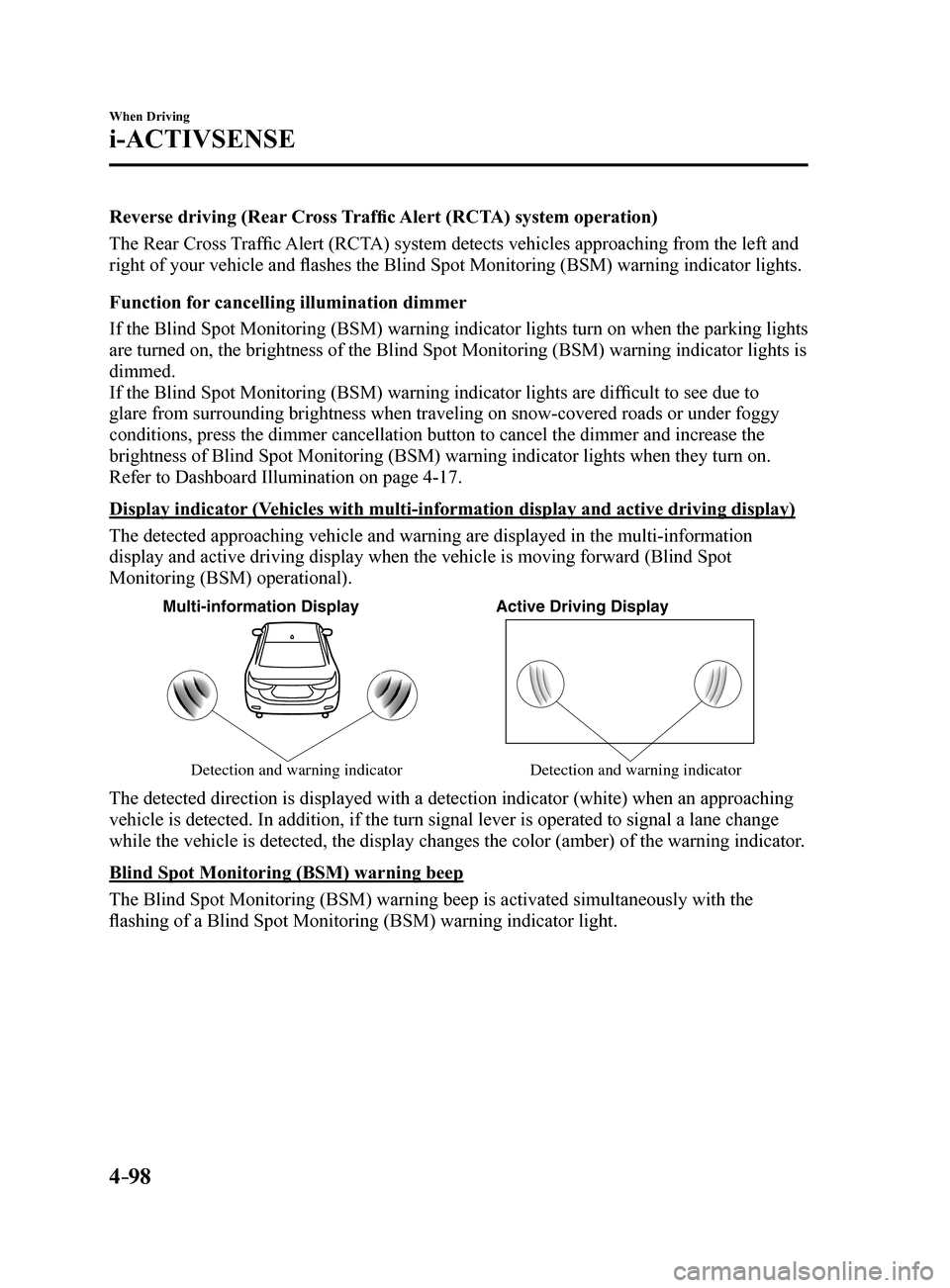
4–98
When Driving
i-ACTIVSENSE
Reverse driving (Rear Cross Traffic Alert (RCTA) system operation)
The Rear Cross Traffic Alert (RCTA) system detects vehicles approaching from the left and
right of your vehicle and flashes the Blind Spot Monitoring (BSM) warning indicator lights.
Function for cancelling illumination dimmer
If the Blind Spot Monitoring (BSM) warning indicator lights turn on when the parking lights
are turned on, the brightness of the Blind Spot Monitoring (BSM) warning indicator lights is
dimmed.
If the Blind Spot Monitoring (BSM) warning indicator lights are difficult to see due to
glare from surrounding brightness when traveling on snow-covered roads o\
r under foggy
conditions, press the dimmer cancellation button to cancel the dimmer an\
d increase the
brightness of Blind Spot Monitoring (BSM) warning indicator lights when they turn on.
Refer to Dashboard Illumination on page 4-17.
Display indicator (Vehicles with multi-information display and active driving display)
The detected approaching vehicle and warning are displayed in the multi-\
information
display and active driving display when the vehicle is moving forward (Blind Spot
Monitoring (BSM) operational).
Multi-information DisplayActive Driving Display
Detection and warning indicator Detection and warning indicator
The detected direction is displayed with a detection indicator (white)\
when an approaching
vehicle is detected. In addition, if the turn signal lever is operated t\
o signal a lane change
while the vehicle is detected, the display changes the color (amber) o\
f the warning indicator.
Blind Spot Monitoring (BSM) warning beep
The Blind Spot Monitoring (BSM) warning beep is activated simultaneously with the
flashing of a Blind Spot Monitoring (BSM) warning indicator light.
Mazda6_8FH2-EA-16F_Edition2.indb 982016/07/07 13:45:06
Page 223 of 578

4–99
When Driving
i-ACTIVSENSE
Canceling Operation of Blind Spot
Monitoring (BSM)
The Blind Spot Monitoring (BSM) system
can be set to inoperable.
Refer to Personalization Features on page
9-10.
When the Blind Spot Monitoring (BSM)
is set to inoperable, the Blind Spot
Monitoring (BSM) and Rear Cross Traffic
Alert (RCTA) systems are turned off and
the Blind Spot Monitoring (BSM) OFF
indicator light in the instrument cluster
turns on.
NOTE
If the engine is stopped while the Blind
Spot Monitoring (BSM) is turned off, the
Blind Spot Monitoring (BSM) becomes
operable the next time the engine is
started.
Mazda6_8FH2-EA-16F_Edition2.indb 992016/07/07 13:45:06
Page 224 of 578
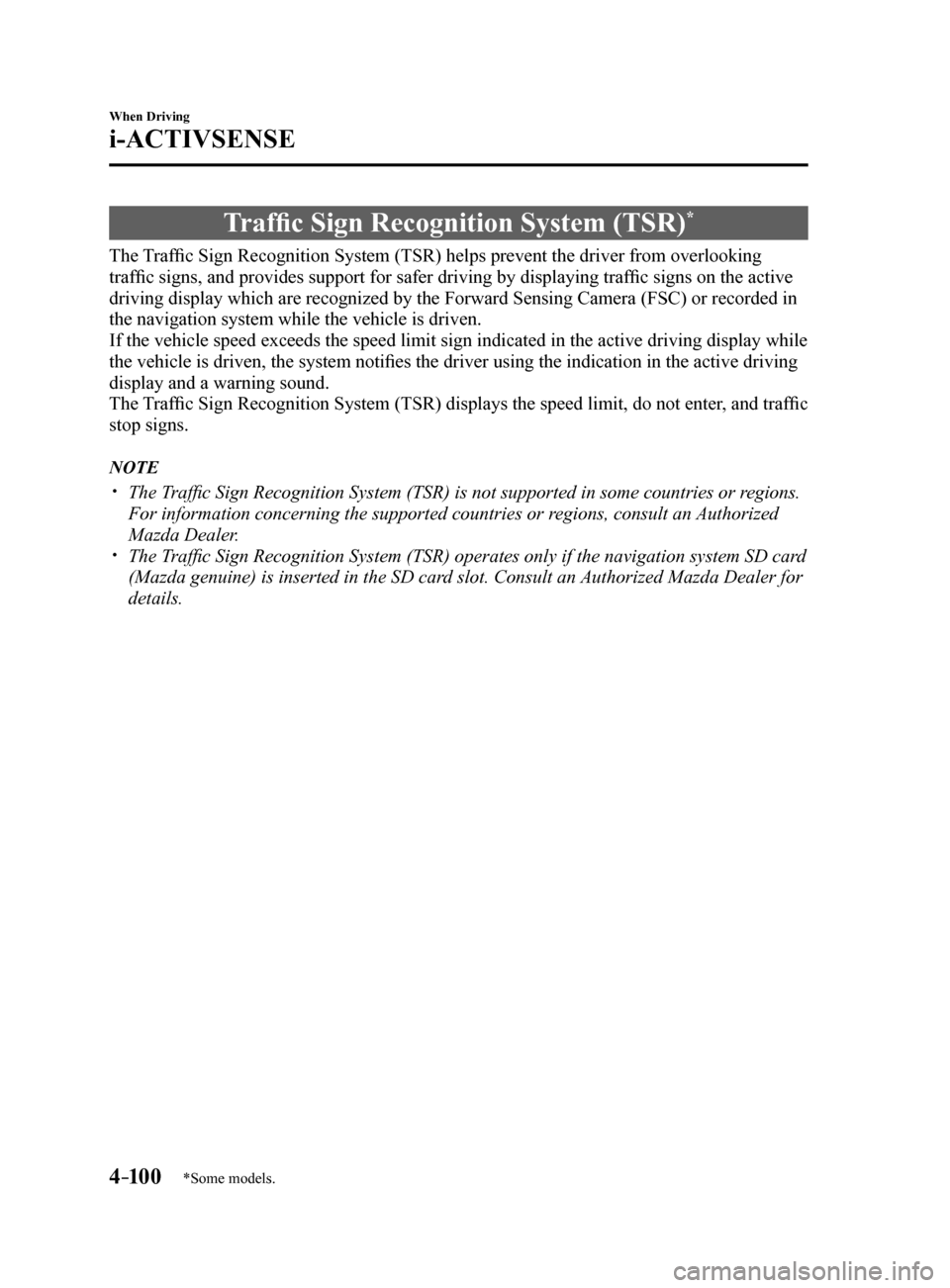
4–10 0
When Driving
i-ACTIVSENSE
*Some models.
Traffic Sign Recognition System (TSR)*
The Traffic Sign Recognition System (TSR) helps prevent the driver from overlooking
traffic signs, and provides support for safer driving by displaying traffic signs on the active
driving display which are recognized by the Forward Sensing Camera (FSC\
) or recorded in
the navigation system while the vehicle is driven.
If the vehicle speed exceeds the speed limit sign indicated in the activ\
e driving display while
the vehicle is driven, the system notifies the driver using the indication in the active driving
display and a warning sound.
The Traffic Sign Recognition System (TSR) displays the speed limit, do not enter, and traffic
stop signs.
NOTE
The Traffic Sign Recognition System (TSR) is not supported in some countries or regions.
For information concerning the supported countries or regions, consult an Authorized
Mazda Dealer.
The Traffic Sign Recognition System (TSR) operates only if the navigation system SD card
(Mazda genuine) is inserted in the SD card slot. Consult an Authorized Mazda Dealer for
details.
Mazda6_8FH2-EA-16F_Edition2.indb 1002016/07/07 13:45:06
Page 225 of 578

4–101
When Driving
i-ACTIVSENSE
Speed limit signs and do not enter signs
Stop sign
WARNING
Always check the traffic signs visually while driving.The Traffic Sign Recognition System (TSR) helps prevent the driver from overlooking traffic
signs and provides support for safer driving. Depending on the weather conditions or
problems with traffic signs, a traffic sign may not be recognized or a traffic sign different
from the actual traffic sign may be displayed. Always make it your responsibility as a
driver to check the traffic signs. Otherwise, it could result in an unexpected accident.
Mazda6_8FH2-EA-16F_Edition2.indb 1012016/07/07 13:45:07
Page 226 of 578
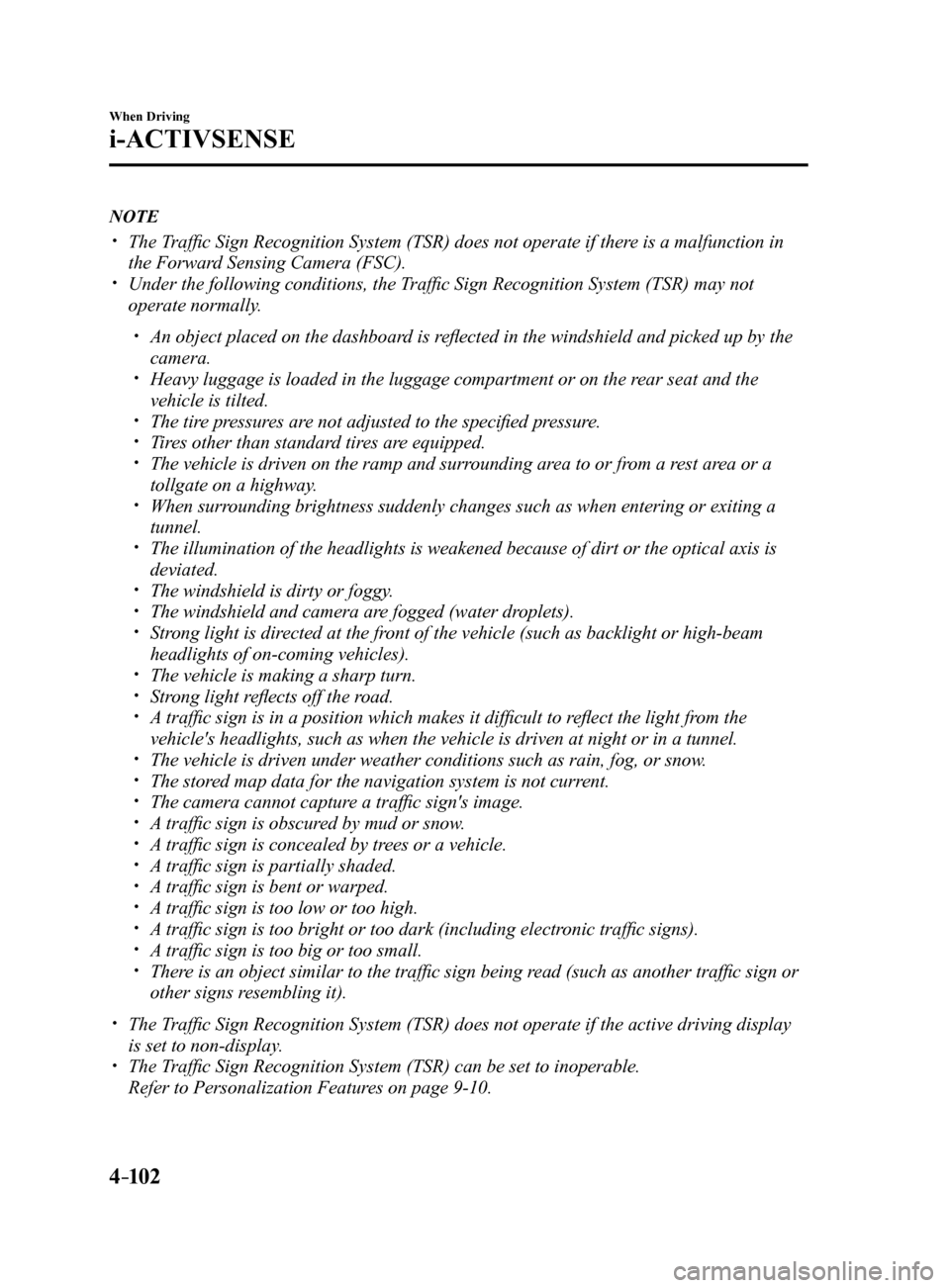
4–102
When Driving
i-ACTIVSENSE
NOTE
The Traffic Sign Recognition System (TSR) does not operate if there is a malfunction in
the Forward Sensing Camera (FSC).
Under the following conditions, the Traffic Sign Recognition System (TSR) may not
operate normally.
An object placed on the dashboard is reflected in the windshield and picked up by the
camera.
Heavy luggage is loaded in the luggage compartment or on the rear seat and the
vehicle is tilted.
The tire pressures are not adjusted to the specified pressure. Tires other than standard tires are equipped. The vehicle is driven on the ramp and surrounding area to or from a rest area or a
tollgate on a highway.
When surrounding brightness suddenly changes such as when entering or exiting a
tunnel.
The illumination of the headlights is weakened because of dirt or the op\
tical axis is
deviated.
The windshield is dirty or foggy. The windshield and camera are fogged (water droplets). Strong light is directed at the front of the vehicle (such as backlight or high-beam
headlights of on-coming vehicles).
The vehicle is making a sharp turn. Strong light reflects off the road. A traffic sign is in a position which makes it difficult to reflect the light from the
vehicle's headlights, such as when the vehicle is driven at night or in \
a tunnel.
The vehicle is driven under weather conditions such as rain, fog, or sno\
w. The stored map data for the navigation system is not current. The camera cannot capture a traffic sign's image. A traffic sign is obscured by mud or snow. A traffic sign is concealed by trees or a vehicle. A traffic sign is partially shaded. A traffic sign is bent or warped. A traffic sign is too low or too high. A traffic sign is too bright or too dark (including electronic traffic signs). A traffic sign is too big or too small. There is an object similar to the traffic sign being read (such as another traffic sign or
other signs resembling it).
The Traffic Sign Recognition System (TSR) does not operate if the active driving display
is set to non-display.
The Traffic Sign Recognition System (TSR) can be set to inoperable.
Refer to Personalization Features on page 9-10.
Mazda6_8FH2-EA-16F_Edition2.indb 1022016/07/07 13:45:07
Page 227 of 578

4–103
When Driving
i-ACTIVSENSE
Traffic Sign Display Indication
The following traffic signs are displayed on the active driving display.
Speed limit signs
Do not enter signs
Stop signs
The above indications are some examples.
Mazda6_8FH2-EA-16F_Edition2.indb 1032016/07/07 13:45:08
Page 228 of 578
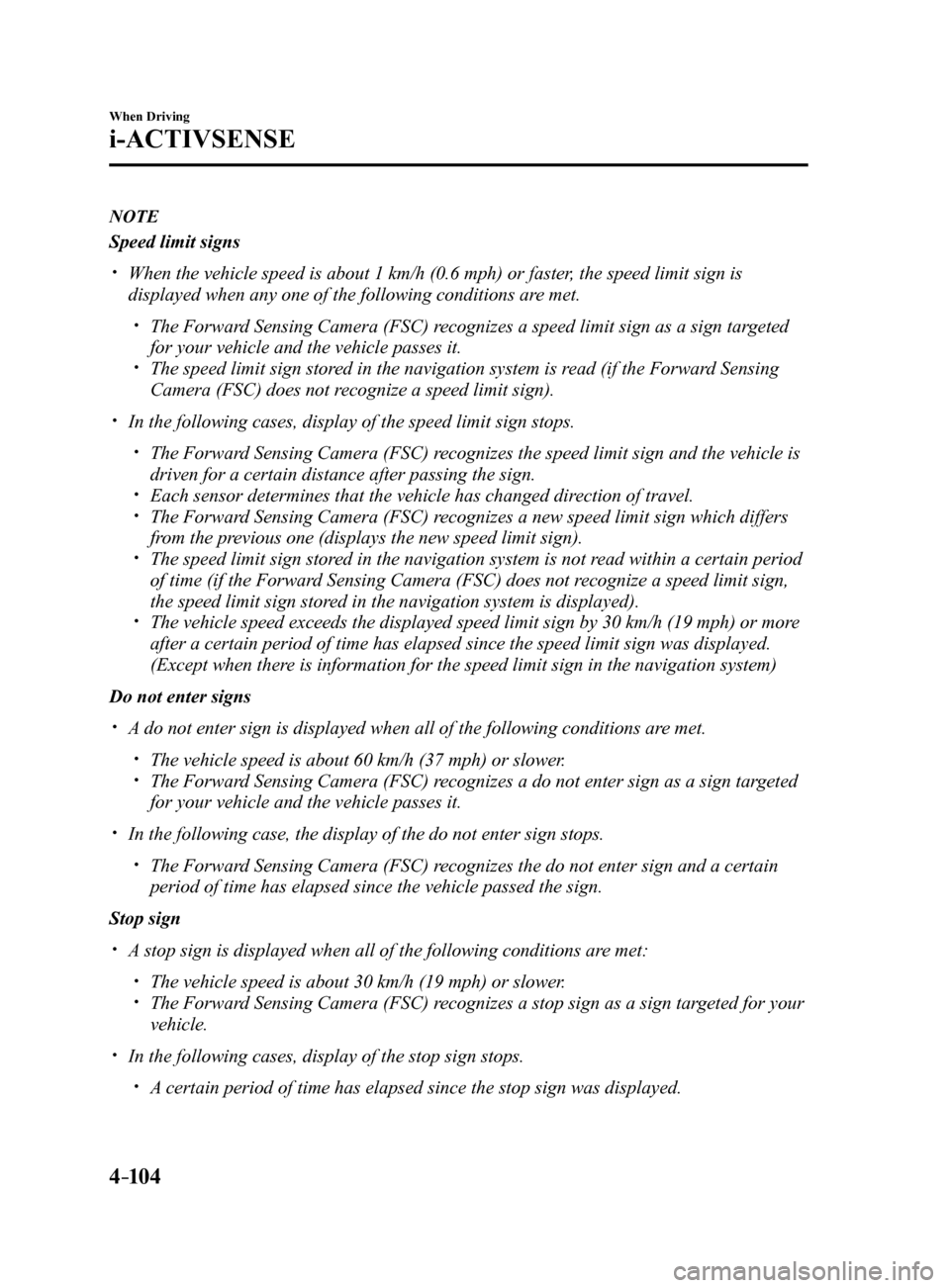
4–104
When Driving
i-ACTIVSENSE
NOTE
Speed limit signs
When the vehicle speed is about 1 km/h (0.6 mph) or faster, the speed limit sign is
displayed when any one of the following conditions are met.
The Forward Sensing Camera (FSC) recognizes a speed limit sign as a sign targeted
for your vehicle and the vehicle passes it.
The speed limit sign stored in the navigation system is read (if the Forward Sensing
Camera (FSC) does not recognize a speed limit sign).
In the following cases, display of the speed limit sign stops.
The Forward Sensing Camera (FSC) recognizes the speed limit sign and the vehicle is
driven for a certain distance after passing the sign.
Each sensor determines that the vehicle has changed direction of travel. The Forward Sensing Camera (FSC) recognizes a new speed limit sign which differs
from the previous one (displays the new speed limit sign).
The speed limit sign stored in the navigation system is not read within a certain period
of time (if the Forward Sensing Camera (FSC) does not recognize a speed limit sign,
the speed limit sign stored in the navigation system is displayed).
The vehicle speed exceeds the displayed speed limit sign by 30 km/h (19\
mph) or more
after a certain period of time has elapsed since the speed limit sign wa\
s displayed.
(Except when there is information for the speed limit sign in the navigation system)
Do not enter signs
A do not enter sign is displayed when all of the following conditions are met.
The vehicle speed is about 60 km/h (37 mph) or slower. The Forward Sensing Camera (FSC) recognizes a do not enter sign as a sign targeted
for your vehicle and the vehicle passes it.
In the following case, the display of the do not enter sign stops.
The Forward Sensing Camera (FSC) recognizes the do not enter sign and a certain
period of time has elapsed since the vehicle passed the sign.
Stop sign
A stop sign is displayed when all of the following conditions are met:
The vehicle speed is about 30 km/h (19 mph) or slower. The Forward Sensing Camera (FSC) recognizes a stop sign as a sign targeted for your
vehicle.
In the following cases, display of the stop sign stops.
A certain period of time has elapsed since the stop sign was displayed.
Mazda6_8FH2-EA-16F_Edition2.indb 1042016/07/07 13:45:08
Page 229 of 578

4–105
When Driving
i-ACTIVSENSE
Excessive Speed Warning
If the vehicle speed exceeds the speed limit sign displayed on the activ\
e driving display,
the warning sound is activated and the area around the speed limit sign \
displayed on the
active driving display flashes 3 times in amber, and if the vehicle speed continues to exceed
the displayed speed limit sign, the indication stops flashing and remains on. Check the
surrounding conditions and adjust the vehicle speed to the legal speed u\
sing the appropriate
operation such as depressing the brake pedal.
Mazda6_8FH2-EA-16F_Edition2.indb 1052016/07/07 13:45:08
Page 230 of 578
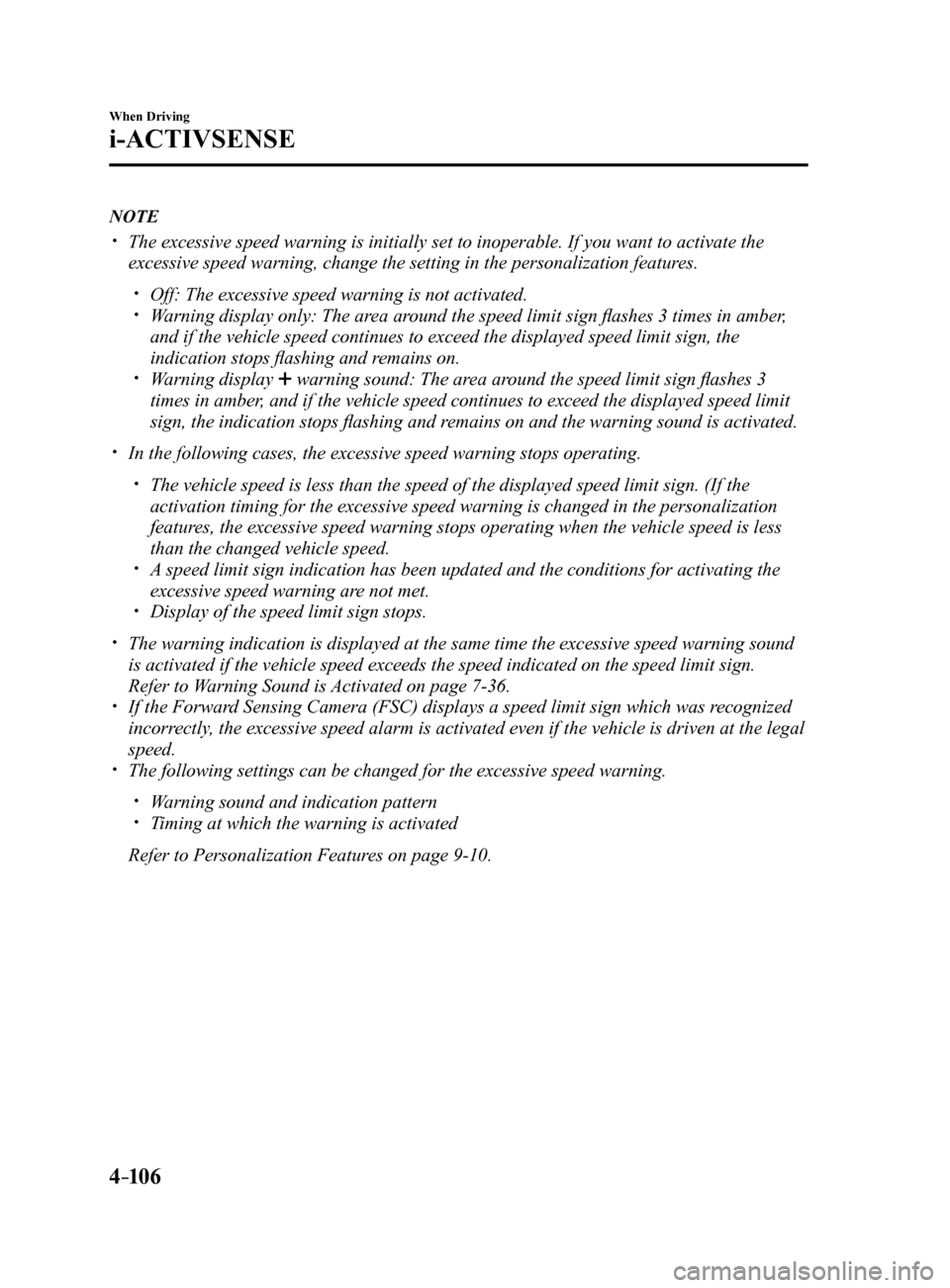
4–106
When Driving
i-ACTIVSENSE
NOTE
The excessive speed warning is initially set to inoperable. If you want \
to activate the
excessive speed warning, change the setting in the personalization featu\
res.
Off: The excessive speed warning is not activated. Warning display only: The area around the speed limit sign flashes 3 times in amber,
and if the vehicle speed continues to exceed the displayed speed limit s\
ign, the
indication stops flashing and remains on.
Warning display warning sound: The area around the speed limit sign flashes 3
times in amber, and if the vehicle speed continues to exceed the displayed speed limit\
sign, the indication stops flashing and remains on and the warning sound is activated.
In the following cases, the excessive speed warning stops operating.
The vehicle speed is less than the speed of the displayed speed limit si\
gn. (If the
activation timing for the excessive speed warning is changed in the pers\
onalization
features, the excessive speed warning stops operating when the vehicle speed i\
s less
than the changed vehicle speed.
A speed limit sign indication has been updated and the conditions for act\
ivating the
excessive speed warning are not met.
Display of the speed limit sign stops.
The warning indication is displayed at the same time the excessive speed\
warning sound
is activated if the vehicle speed exceeds the speed indicated on the spe\
ed limit sign.
Refer to Warning Sound is Activated on page 7-36.
If the Forward Sensing Camera (FSC) displays a speed limit sign which was recognized
incorrectly, the excessive speed alarm is activated even if the vehicle is driven a\
t the legal
speed.
The following settings can be changed for the excessive speed warning.
Warning sound and indication pattern Timing at which the warning is activated
Refer to Personalization Features on page 9-10.
Mazda6_8FH2-EA-16F_Edition2.indb 1062016/07/07 13:45:08